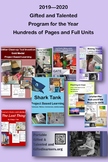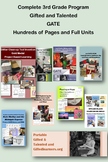Toy Car Golf Math STEAM Design - Gifted and Talented GATE 2nd-4th 9 Hours
- Word Document File
What educators are saying
Also included in
- Kids make them and then play them. Because we are tricky teachers, we can incorporate engaging activities that teach standards! See individual units for a full preview.Price $24.99Original Price $48.91Save $23.92
- Hours and hours and hundreds and hundreds of pages. Renew, refresh, and re-energize with engaging, challenging hands-on products!THESE PROGRAMS FOR THE YEAR ARE MY MOST POPULAR PRODUCTS.Inspire your students with FLOATING ON HOPE. Your youngest KG kids and 1st graders will love MAKING TRACKS. ThePrice $19.99Original Price $37.91Save $17.92
- Everything you need to get you through a year of talent pools -- maybe more. It's all kid-tested in my own classroom. Highly engaging and challenging!My 3-4 and 4th grade Volume 1 bundles carry excellent reviews . . . but I think this bundle is even a little better as I have developed and enhancedPrice $26.99Original Price $44.42Save $17.43
Description
Engaging math and engineering with ramps and toy cars! Your students will go home and share the news about how absolutely cool school seems now. My mathematically gifted 2nd graders were VERY Challenged by this unit, and I would not hesitate to use it for 3rd grade GATE or in 4th grade as an enrichment for the whole class.
Schoolhouse Rock Math: We’re using Zero My Hero and 5’s Multiplication to learn multiplication, repeated addition, and patterns to calculate areas of rectangles—a very advanced skill for my 2nd graders. My 3rd graders will need an introduction or review of area, and while 3rd graders are just memorizing their multiplication facts, the Schoolhouse Rock videos will be fun for them.
Ramps—From Nets to Surface Area: We use cardstock ramps for several purposes. These ramps are constructed from nets we piece together (little hands are challenged to assemble these). We also discuss surface area and the relationship between rectangles and triangles. We use the ramps with a toy car to gather data, and later we will use the ramps as the “tee box” in our “toy car golf course.”
Data Gathering: We will use our ramps to gather data using a toy car, a ruler, and a data sheet. We measure the distance the car travels away from the ramp to the nearest ¼ inch and record the distance on the data sheet. Yep, 1/4th of an inch . . . we’re not just playing around here! We follow up with videos and discussions about Newton’s Laws.
Adding Fractions: Let’s keep in mind that many of our math kids love to calculate and most certainly need to be challenged. In this activity, we’re getting ready to add the fractions and whole numbers in the data set we’ve collected with the cars and ramps. Afterwards, we add our data sets together so that we can calculate mean, median, and mode. This is very advanced for these younger kids!
The Smarty Party Challenge: In this applied math challenge, students use a data set to make a prediction. Do we use mean, median, or mode to make the strongest prediction? Let’s put it to the test!
Toy Car Golf: In our culminating series of activities, students design a toy car golf course using their ramps as the tee box. The toy cars serve as “golf balls,” and the golfers push the car forward to complete a hole designed by a classmate. Along the way, golfers encounter obstacles and creative challenges as they try to maneuver through the course for the lowest score.
Score Card and Data Collection 2.0: We create a scorecard while practicing geometry, graphic design, and for an opportunity to revisit both area and fractions. In this lesson, students use their language abilities to brainstorm a course name and then design an eye-catching banner or logo.
Final Data Analysis: We chart our results with a bar graph—making sure we include all of the components of a good chart. Was our predicted score too high or too low?
Tools and Materials
· Rulers
· Clipboards
· Cardstock
· Tape
· Toy cars – such as Hot Wheels
Time: This took my 2nd graders 9 hours—one quarter of pull-outs
Level: GATE 2nd Grade through 4th grade whole class enrichment








